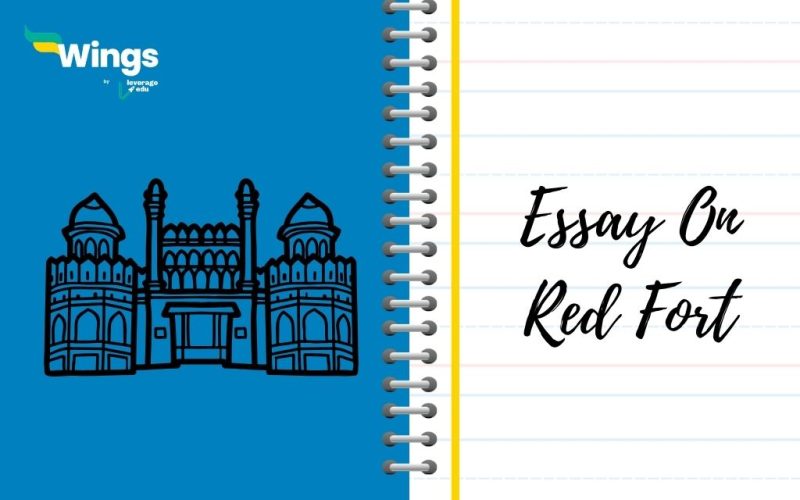Essay on Red Fort: The Red Fort is one of the most famous historical monuments and tourist attractions in India. Made up of red stones, the fort was constructed in 1526 AD by Shah Jahan. The monument is a fusion of Mughal, Persian, Hindu, and Timurid architecture. This 75-foot-high structure is made of entertainment halls, geometrical gardens, palaces, indoor canals and baths, balconies, and a mosque.
Since its construction, Red Fort has been associated with power. From the throne of the Mughal Empire to the military base of the British Empire, the monument has witnessed many chapters of history. The significance of Red Fort was elated when the first Prime Minister of India Jawaharlal Nehru declared the independence of India from this historical monument.
Also Read: Revisit the Landmarks of Indian Independence Struggle!
Table of Contents
Essay on Red Fort in 100 words
The Red Fort, or Lal Qila, which is located in Old Delhi, is one of the most cherished monuments in India. It was the throne of the Mughal Emperor Shah Jahan and his successors.
The wall of the building, which is the centre of attraction for many people, is made up of red sandstone. The interior rooms of the building are built in a row of pavilions connected by a canal called Nahr-i-Behisht, also called the Stream of Paradise. The monument is praised for its unique structure, which reflects Islamic, Hindu, Persian, and Timurid architectural plans.
Red Fort is thus a beautiful piece that represents the innovative ideas of architects of the Mughal period.
Also Read: Speech on Tourism in India for School Students
Source: Narendra Modi’s Twitter Account
Also Read: How to Prepare for UPSC in 6 Months?
Essay on Red Fort in 200 words
Red Fort was chosen as one of the World Heritage Sites of UNESCO in 2007. The historical monument is a beautiful structure reflecting architectural marvels, which still amazes every visitor.
The interior of the building is mainly divided into four parts, which are: the Diwan-i-Am, which means the Hall of Audience; the Diwan-i-Khass, popularly known as the ´Hall of Private Audience’; the Tasbih-Khana, also called the ´Chamber for beads for private prayers; and the Hammam, or ´The Bath.´ The lower part of the corridors connected to the bath has beautiful floral decorations of Parchin kari, and the upper part is painted golden in colour.
The Hammam, or bath, was not ordinary. It was divided into three main rooms with beautiful, stoned corridors. Moreover, a sacred chamber called Tasbih-Khana was built especially for offering prayers by counting the beads.
Thus, the variety of structures in Red Fort makes it an ideal heritage site.
Also Read: Happy Independence Day 2023
Essay on Red Fort in 300 words
The Red Fort is a historical monument in India. Apart from its beautiful construction, the fort has importance in the history of independence. Have you ever wondered why the Prime Minister of India addresses the nation from the magnificent red-coloured stone building?
The rebellion history of India started in the year 1857, which is often called the Indian Rebellion of 1857 or the Sepoy Mutiny. The reasons that led to the First War of Independence by the sepoys were based on several reasons, such as political dissatisfaction among the Indian soldiers and racism or racial discrimination among Indians. Among the reasons, the main cause was believed to be the introduction of new rifle cartridges that were greased with cow and pig fat. As the sepoys had to bite the cartilage before loading it into the rifle, this hurt the religious factors of Hindu and Muslim soldiers in the British Army.
It was on May 10, 1857, when the revolt started in Meerut and quickly spread to Delhi. Bahadur Shah II also participated and became the leader of the rebellion. The rebels, who were sepoys and civilians, on the issue of a proclamation by their reluctant leader for unity against the British, marched towards the Red Fort and turned the building into a centre of resistance during the rebellion.
Unfortunately, the British recaptured Delhi in September 1857. Out of revenge, the Britishers destroyed three-fourths of Red Fort and Delhi. Not only was the building destroyed, but it was also looted, stripped of valuables, and disfigured. The motive behind all this destruction was to showcase the dominance of the British and British Raj towards the people of India afterwards.
All these ghastly acts of the Britishers filled the Indians with rage, which was later followed by many movements and violent revolts against the rule of the British government. Over the years, Red Fort, which once stood as a belief in India’s rich history, was restored, and on August 15, 1947, when Jawaharlal Nehru hoisted the Indian National Flag on Red Fort to shatter the symbol of imperial dominance.
Also Read: My Experiments With Truth: Autobiography of Mahatma Gandhi
FAQs
Ans. The main feature that makes Red Fort unique is the architecture. The building is divided into four parts: The Diwan-i-Am which means the Hall of Audience, The Diwan-i-Khass, popularly known as the ´Hall of Private Audience´, The Tasbih-Khana also called the ´Chamber for beads for private prayers), and The Hammam or ´The Bath.´
Ans. 1. Red For is a white colour building built with red stones.
2. The real name of Red Fort is Qila-e-Mubarak.
3. It took 10 years to build the Red Fort.
4. The shape of the Red Fort is Octagonal.
Ans. The old name of Red Fort is Qila-i-Mubārak, which means The Blessed Fort.
Ans. Red Fort is famous for its unique architecture and the beginning of the Revolt of Independence, in 1857.
Ans. Red Fort was designed by famous architect Ustad Ahmad Lahori and its construction was commissioned by Emperor Shah Jahan.
Related Articles
For more information on such interesting topics, visit our essay writing page and follow Leverage Edu.
 One app for all your study abroad needs
One app for all your study abroad needs













